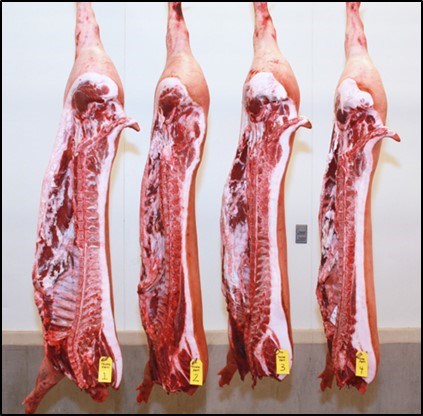

African Swine Fever Negatively Impacts Global Pork Production
April 23, 2024
Diseases affecting wild and domestic swine (Sus scrofa) play a significant role in the success of the global pork industry. Supply chains have faced substantial challenges in recent years due to African swine fever (ASF), a highly contagious viral disease that affects both domestic and wild pigs. This virus is transmitted by direct contact with infected animals or indirect contact with contaminated objects. Symptoms in swine are characterized by high fevers, hemorrhages, and high mortality rates, reaching up to 100% in some cases. Fortunately, humans cannot contract ASF and no cases have been confirmed in the United States through the rigorous monitoring and surveillance protocols enacted by the United States Department of Agriculture Animal and Plant Health Inspection Service (USDA-APHIS). However, the disease has still taken a substantial toll on global pork production and trade.
Global pork production and trade
Countries affected by ASF experience reduced pig populations due to mass culling, export restrictions, and trade disruptions. ASF resulted in a decline of 20-50% of pig populations in affected regions1. More recently, outbreaks in Asian countries including North and South Korea, Indonesia, Vietnam and China caused mortality or culling of domestic pigs, with approximately 225 million swine in China alone from 2018-20192,3.


Figure 1. Global shipping and trade of pork were significantly impacted during an outbreak of ASF in Asian countries including North Korea, South Korea, Indonesia, Vietnam and China from 2018-2019. (Image Credit – AgriLife Today)
Economic consequences
The economic consequences of ASF can be severe—the loss of pig populations and reduced pork production result in decreased income for farmers, increased prices for consumers, and reduced revenues for the whole pork industry. The estimated economic impact of ASF in China alone approached $119B over a decade5. In Vietnam, 20% of pigs died or were culled within the first 5 months after the onset of the outbreak, with an economic impact between $880M and $4.4B in 20192. In 2020, India lost $37.32M from ASF swine mortality from June to April3.
Market instability and trade restrictions
ASF outbreaks often lead to market instability and trade restrictions when affected countries impose bans or restrictions on pork imports from regions where ASF is prevalent. These trade restrictions disrupt global pork trade patterns and create market uncertainties. For example, ASF in China led to a significant reduction in pork imports, affecting both exporting countries and global pork prices5.

Figure 2. Outbreaks of ASF abroad can result in extensive swine culling, which can reduce market availability and increase international pork prices. (Image Credit - https://aggiemeat.tamu.edu/)
Farm-level impacts
ASF outbreaks also impose challenges at the farm level where mortality calls for quick action to depopulate and mitigate disease spreading. This causes negative psychological impacts for farmers, who have attributed these issues to the inherent severity of ASF outbreaks6. ASF outbreaks can lead to substantial financial losses, and negatively impact the ability of small operations to continue in the pork production business.
Environmental consequences
Carcass disposal during an ASF outbreak can have environmental consequences7. Improper disposal methods can lead to the contamination of soil, water sources, riparian areas, and surrounding ecosystems. The contamination may also persist within ecosystems, posing a risk of ASF transmission to wild pigs or other susceptible animals7. Research found that African wild swine, including warthogs (Phacochoerus africanus) and bush pigs (Potamochoerus larvatus), were predominately asymptomatic when infected8 (Figure 3). Asymptomatic infection has also been shown to occur infrequently among Sus scrofa, but not nearly to the extent found in their Suidae kin, African wild swine.

Figure 3. Because North American wild swine can be asymptomatic, this raises concern for U.S. pork producers. African wart hogs and bush pigs contracting ASF mostly presented few or no symptoms8.
Potential impacts on North American wild and domestic pig populations
It is good that we have ongoing monitoring and surveillance by USDA-APHIS, but we also need better understanding of how the public would perceive and react to an ASF outbreak in North America. Some groups might initially view an outbreak as beneficial, given the reduction of wild pig populations and the damage they cause. However, given high transmission of ASF from wild to domestic swine and vice versa, such an outbreak would likely result in severe economic consequences similar to those incurred in Asian countries.
While no cases of ASF have been confirmed in North America, outbreaks did occur in the Dominican Republic as recently as 2021 according to the American Veterinary Medical Association. During these outbreaks, at least 2,200 pigs succumbed to the disease or were culled during containment protocol9,10. The proximity of these outbreaks to North America raises concern for potential outbreaks in the United States.
Conclusion
ASF has had a significant and far-reaching impact on wild and domestic pig populations and the pork industry. It has caused substantial economic losses, disrupted global pork production and its related businesses and created market instability. Concern has also been raised that improper disposal of infected carcasses could lead to negative water quality and environmental impacts. Efforts to control and prevent ASF are crucial in safeguarding the sustainability and profitability of the pork industry worldwide. In the U.S., continued domestic/wild swine monitoring and surveillance protocols as well as vaccine development efforts remain necessary in mitigating the impacts of any potential future ASF outbreak in North America.
--
Cover photo: Texas A&M AgriLife Extension Service
Literature Cited
- Costard, S., L. Mur, J. Lubroth, J.M. Sanchez-Vizcaino and D.U. Pfeiffer. 2013. Epidemiology of African swine fever virus. Virus Research 173(1): 191-197.
- Nguyen‐Thi, T. , L. Pham‐Thi‐Ngoc, Q. Nguyen‐Ngoc, S. Dang‐Xuan, H.S. Lee, H. Nguyen‐Viet, P. Padungtod, T. Nguyen‐Thu, T. Nguyen‐Thi, T. Tran‐Cong and K.M. Rich. 2021. An assessment of the economic impacts of the 2019 African Swine Fever Outbreaks in Vietnam. Frontiers in Veterinary Science 8: 686-691.
- Mohan, N. H., M.M. Misha and V.K Gupta. 2021. Consequences of African swine fever in India: Beyond economic implications. Transboundary and Emerging Diseases 68: 3009–3011.
- Guinat, C., A. Gogin, S. Blome, G. Keil, R. Pollin and D.U. Pfeiffer. 2016. Transmission routes of African swine fever virus to domestic pigs: current knowledge and future research directions. Veterinary Record 178(11): 262-267.
- Schulz, K., C. Staubach, S. Blome, I. Nurmoja, A. Viltrop and F.J. Conraths. 2019. African swine fever: Fast and furious or slow and steady? Viruses 11(10), 866.
- Huang, Y., T. Xu, X. Wang, Y. Wang, G. Yang, A. Chen and D. Liu. 2020. African swine fever: Historical, current and future perspectives. Journal of Advanced Research 24: 283-289.
- Duc, H. M., P. H. Ngan, H. M. Son, N. T. Lan, L. Van Hung, C. T. Ha, N. T. Hoa, T. Q. Lam, N. Van Thang, G. A. Flory and M. Hutchinson. 2022. The use of composting for the disposal of African swine fever virus-infected swine carcasses. Transboundary and Emerging Diseases 69(5):e3036-e3044.
- Penrith, M.L., W. Vosloo, F. Jori, and A. D. S. Bastos. 2013. African swine fever virus eradication in Africa. Virus Research 173:228–246.
- United States Department of Agriculture. 2021. USDA Statement on Confirmation of African Swine Fever in the Dominican Republic. USDOA Animal and Plant Health Inspection Service, USDA.
- Ruiz-Saenz, J., A. Diaz, D.K. Bonilla-Aldana, A.J. Rodríguez-Morales, M. Martinez-Gutierrez and P.V. Aguilar. 2022. African swine fever virus: A re-emerging threat to the swine industry and food security in the Americas. Frontiers in Microbiology 13: 1011891.
Learn More
Wild Pigs in Texas
Educating and equipping landowners and stakeholders to manage wildlife and natural resources in Texas







